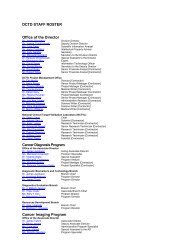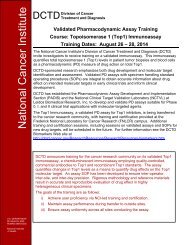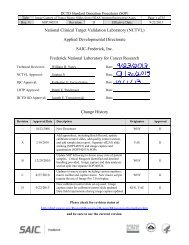National Cancer Institute - NCI Division of Cancer Treatment and ...
National Cancer Institute - NCI Division of Cancer Treatment and ...
National Cancer Institute - NCI Division of Cancer Treatment and ...
Create successful ePaper yourself
Turn your PDF publications into a flip-book with our unique Google optimized e-Paper software.
This included a camptothecin derivative<br />
never before found in nature. Structure<br />
elucidation work is in progress for compounds<br />
isolated from all three screens.<br />
Two novel antifungal compound series<br />
were reported in 2005. These represented<br />
the conclusion <strong>of</strong> work under a CRADA<br />
with SAIC for antimicrobial drug discovery.<br />
DTP Screening Technologies Branch (STB)<br />
investigators developed a novel fermentation<br />
process to produce the antitumor<br />
lead pleurotin <strong>and</strong> supported a large-scale<br />
plant recollection effort to isolate novel<br />
tropane alkaloids.<br />
Meragelman TL, Tucker KD, McCloud TG,<br />
Cardellina JH 2nd, Shoemaker RH. Antifungal<br />
flavonoids from Hildegardia barteri. J Nat Prod<br />
2005;68:1790–2.<br />
Klausmeyer P, McCloud TG, Tucker KD, Cardellina<br />
JH 2nd, Shoemaker RH. Aspirochlorine class<br />
compounds from Aspergillus flavus inhibit<br />
azole-resistant C<strong>and</strong>ida albicans. J Nat Prod<br />
2005;68:1300–2.<br />
Chin YW, Jones WP, Waybright TJ, McCloud TG,<br />
Rasoanaivo P, Cragg GM, Cassady JM, Kinghorn<br />
AD. Tropane aromatic ester alkaloids from a<br />
large-scale re-collection <strong>of</strong> Erythroxylum pervillei<br />
stem bark obtained in Madagascar. J Nat Prod<br />
2006;69:414–7.<br />
Shipley SM, Barr AL, Graf SJ, Collins RP, McCloud<br />
TG, Newman DJ. Development <strong>of</strong> a process for<br />
the production <strong>of</strong> the anticancer lead compound<br />
pleurotin by fermentation <strong>of</strong> Hohenbuehelia<br />
atrocaerulea. J Ind Microbiol Biotechnol<br />
2006;33:463–8.<br />
118 ■ P R O G R A M A C C O M P L I S H M E N T S 2 0 0 6<br />
Development <strong>of</strong> Novel High-<br />
Throughput Screening Technology<br />
for Identification <strong>of</strong> Inhibitors <strong>of</strong><br />
Transcription Factor-DNA Binding<br />
STB investigators worked with Dr. Charles<br />
Vinson, CCR Laboratory <strong>of</strong> Metabolism,<br />
to develop, optimize, <strong>and</strong> characterize a<br />
screen for four <strong>of</strong> the B-Zip family <strong>of</strong> transcription<br />
factors that are known to have<br />
oncogenic effects. A high-throughput<br />
screen <strong>of</strong> the <strong>NCI</strong> diversity set identified a<br />
single chemotype effective in disrupting<br />
B-Zip–DNA interactions. Further work is<br />
in progress to define the activity <strong>of</strong> this<br />
chemotype in cell-based reporters for<br />
B-Zip activity <strong>and</strong> to evaluate additional<br />
leads identified in high-throughput<br />
screening <strong>of</strong> chemical libraries. STB investigators<br />
have generalized this technology<br />
to develop a screen for inhibitors <strong>of</strong> ASPL-<br />
TFE3 chimeric transcription factor-DNA<br />
interaction. This chimeric transcription<br />
factor results from a chromosomal translocation<br />
characteristic <strong>of</strong> alveolar s<strong>of</strong>t-part<br />
sarcoma. In sarcoma <strong>and</strong> in other pediatric<br />
tumors, such as alveolar rhabdomyosarcoma,<br />
the chromosomal translocation<br />
<strong>and</strong> associated chimeric transcription<br />
factor present a potentially exploitable<br />
therapeutic target.<br />
Rishi V, Potter T, Laudeman J, Reinhart R, Silvers<br />
T, Selby M, Stevenson T, Krosky P, Stephen AG,<br />
Acharya A, Moll J, Oh WJ, Scudiero D, Shoemaker<br />
RH, Vinson C. A high-throughput fluorescenceanisotropy<br />
screen that identifies small molecule<br />
inhibitors <strong>of</strong> the DNA binding <strong>of</strong> B-ZIP transcription<br />
factors. Anal Biochem 2005;340:259–71.










